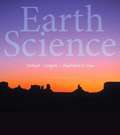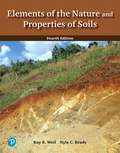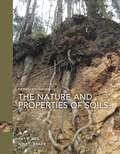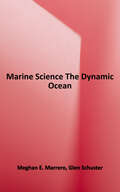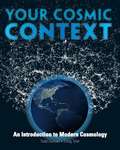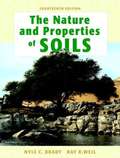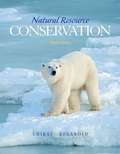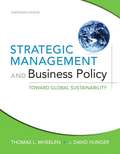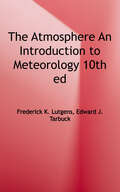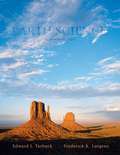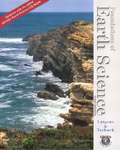- Table View
- List View
Prentice Hall Science Explorer Georgia Earth Science
by Michael J. Padilla Ioannis Miaoulis Martha CyrNIMAC-sourced textbook
Prentice Hall Science Explorer Georgia Earth Science
by Michael J. Padilla Ioannis Miaoulis Martha CyrNIMAC-sourced textbook
Prentice Hall Earth Science: Physical Setting/Earth Science, New York
by Edward J. Tarbuck Frederick K. Lutgens Dennis TasaNIMAC-sourced textbook
Prentice Hall Earth Science
by Edward J. Tarbuck Frederick K. Lutgens Dennis TasaNIMAC-sourced textbook
Prentice Hall Earth Science
by Edward J. Tarbuck Frederick K. Lutgens Dennis TasaNIMAC-sourced textbook
Earth Science
by Edward J. Tarbuck Frederick K. LutgensIdeal for undergraduates with little or no science background, Earth Science provides a student-friendly overview of our physical environment that offers balanced, up-to-date coverage of geology, oceanography, astronomy, and meteorology. The authors’ texts have always been recognized for their readability, currency, dynamic art program, delivery of basic principles and instructor flexibility. The Fourteenth Edition incorporates a new active learning approach, a fully updated and mobile visual program, and MasteringGeology™–the most complete, easy-to-use, engaging tutorial and assessment tool available.
Elements Of The Nature And Properties Of Soils
by Nyle Brady Raymond WeilAt the forefront of soil science for over a century, Elements of the Nature and Properties of Soils considers the role of soils as both a natural resource and an ecosystem, while highlighting interactions between soils and other components of natural and constructed ecosystems. With practical value for meeting today’s environmental challenges, the text asserts that balancing economic growth with sustainable economies requires a deep understanding of soils. The 4th edition has been abridged to focus on fundamentals, while providing new or updated discussions on topics such as soils and human health, organic farming, and soil food-web ecology.
The Nature and Properties of Soils
by Nyle Brady Ray Weil<p>This hallmark text introduces the exciting world of soils through clear writing, strong pedagogy, and an ecological approach that effectively explains the fundamentals of soil science. Worked calculations, vignettes, and current real-world applications prepare readers to understand concepts, solve problems, and think critically. Written for both majors and non-majors, this text highlights the many interactions between the soil and other components of forest, range, agricultural, wetland and constructed ecosystems. <p>Now in full-color, the Fifteenth Edition includes hundreds of compelling photos, figures, and diagrams to bring the exciting world of soils to life. Extensively revised, new and updated content appears in every chapter. Examples include: coverage of the pedosphere concept; new insights into humus and soil carbon accumulation; subaqueous soils, soil effects on human health; principles and practice of organic farming; urban and human engineered soils; new understandings of the nitrogen cycle; water-saving irrigation techniques; hydraulic redistribution, soil food-web ecology; disease suppressive soils; soil microbial genomics; soil interactions with global climate change; digital soil maps; and many others.</p>
Marine Science: The Dynamic Ocean
by Meghan E. Marrero Glen SchusterThis book is a truly integrated science course in which the science concepts are applied to authentic scientific settings, scenarios, and investigations. You will simultaneously learn about life, Earth, and physical sciences. As you explore real-world data, you get a unique and fresh perspective on the ocean, its inhabitants, and its processes. Science concepts such as plate tectonics, food and energy transfer, and the properties of water come to life as you participate in Student Expert teams that focus on the seafloor, marine food sources, and the sea's surface. <p><p>This curriculum program parallels other textbook programs, yet there are some notable distinctions in the way it was put together. Rather than chapters, the book is divided into 34 Lessons, each of which will help you to build your understanding about the ocean and its processes. Marine Science: The Dynamic Ocean gives you the opportunity to access and interpret data sets, including oceanographic, meteorological, and animal tracking observations. You will also participate in fieldwork, assessing local water quality and your school's potential contribution to marine pollution.
Physical Science: Concepts in Action
by Sophia Yancopoulos David Frank Michael WysessionNIMAC-sourced textbook
Earth Science
by Edward J. Tarbuck Frederick K. Lutgens Dennis TasaThe latest edition (fifth was 1988) of a broad and nonquantitative survey at the introductory level of topics in geology, oceanography, meteorology, and astronomy.
Earth Science
by PearsonEarth Science, 13th Edition, is designed for an 11th or 12th grade course in Earth science. It consists of seven units that emphasize broad and up-to-date coverage of basic topics and principles in geology, oceanography, meteorology, and astronomy. The book is intended to be a meaningful, nontechnical survey for students. In addition to being informative and up-to-date, Earth Science, 13th Edition strives to meet the need for a readable and user- friendly text and a highly usable "tool" for learning basic Earth science principles and concepts.
Alabama Grade 7 Prentice Hall Science Explorer
by Cyr Padilla MiaoulisLead author Michael Padilla once again sets the standard for engaging, hands-on science exploration. Correlates to Alabama state standards.
Your Cosmic Context: An Introduction to Modern Cosmology
by Todd Duncan Craig TylerYour Cosmic Context provides a framework for exploring the nature and history of our universe. Equally well suited for independent reading and study or for a one-term general education course in cosmology, this book is a guide to the key insights of scientific cosmology, including the big bang theory and exotic entities like dark matter and dark energy. It also explains how we discovered the surprising things we now know about the distant reaches of space and time, and thereby serves as one of the best available illustrations of the scientific method in action.
The Nature and Properties of Soils
by Nyle C. Brady Ray R. WeilThe Nature and Property of Soils is an engaging book for readers. It has an ecological approach that explains the fundamentals of soil science effectively. Chapter topics include Soil Erosion and Its Control, Soil Acidity, Soils and Chemical Pollution, and Organisms and the Ecology of the Soil. For individuals interested in soil and the environment.
Natural Resource Conservation: Management For A Sustainable Future
by Daniel Chiras John ReganoldThis comprehensive book describes the ecological principles, policies, and practices required to create a sustainable future. It emphasizes practical, cost-effective, sustainable solutions to these problems that make sense from social, economic, and environmental perspectives. A focus on sustainable development puts readers in touch with one of the most significant shifts in thinking and action in the environmental and resource management arenas. A variety of lasting solutions are provided that make sense from social, economic, and environmental viewpoints.
Strategic Management And Business Policy: Toward Global Sustainability, 13th Edition
by Thomas L. Wheelen J. David HungerThis text equips readers with the strategic concepts they will need to know as we face issues such as climate change, global warming and energy availability. This thirteenth edition provides an array of timely, well-researched, and class-tested cases--nineteen of which are new or revised.
The Atmosphere: An Introduction to Meteorology
by Frederick K. Lutgens Edward J. TarbuckUsing everyday, easy-to-grasp examples to reinforce basic concepts, this highly regarded handbook remains the standard introduction to meteorology and the atmosphere – components, problems, and applications. Includes the most up-to-date coverage of topics such as: ozone depletion; the ultraviolet index; temperature; dew point temperature and orographic effects; wildfires and weather; thunderstorms and lightning; the record-breaking Florida hurricane season; effects of air pollution, and more. Incorporates top-quality visuals, including new satellite images and illustrations by the award-winning Dennis Tasa, to demonstrate the highly visual nature of meteorology. Uses a largely non-technical writing style to help readers grasp important concepts. For those interested in learning more about meteorology.
The Cooling
by Lowell PonteAre we entering a new ice age? Many scientists think so. Many others say that the climate is becoming unstable, and that this instability is a critical threat to world food production. Earth's climate has been cooling rapidly for the past three decades, and this has already caused drought and famine in major areas of the world. In the time it takes you to read this book, at least a thousand people will have starved to death because of the impact climatic instability already has had on food production. And The Cooling has barely begun. Few questions are as urgent today as those concerning climate change and what may be done about it. Dr. Cesare Emiliani, a "paleoclimatologist" at the University of Miami, says: "Is Earth's climate changing? Should governments try to modify climate? In dealing with these controversial issues, Lowell Ponte has written a remarkably thorough, far-ranging, balanced, and scientifically accurate book-the best popular book I have read on both these questions. I recommend THE COOLING to anyone who likes to think, and who cares about the planet we share."
An Event-Based Science Module: Earthquake!
by Russell G. WrightEarthquake! is an earth-science unit that follows the Event-Based Science (EBS) Instructional Model and is built around simulations of real-life events and experiences that affected people's lives and environments dramatically.
Prentice Hall Earth Science (11th edition)
by Edward J. Tarbuck Frederick K. Lutgens Dennis TasaThe latest edition of a broad and nonquantitative survey at the introductory level of topics in geology, oceanography, meteorology, and astronomy.
Foundations of Earth Science (3rd edition)
by Frederick K. Lutgens Edward J. TarbuckThis book offers a user-friendly overview of the physical environment. It retains the hallmarks expected from author's reader-friendly writing style, carefully crafted art program, and coverage of the most recent current events. It discusses key topics such as Earth materials, earth's external and internal processes, Earth's history, the global ocean, and the atmosphere.

